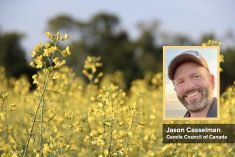Glacier FarmMedia – When deciding between a pre-harvest or post-harvest spray application to control tough perennial weeds, there are always some key considerations for farmers. The extent of the weed problem and harvest timing are important ones, of course, but other factors such as herbicide cost and killing frost also play into the decision.
To control a weed like Canada thistle, it’s not a question of which option works best but what you’re hoping to achieve with your herbicide treatment.
For example, the following scenario is a common one. If a farmer has a canola field with a lot of perennial escapes, especially big, tough weeds like Canada thistle, is it better for that farmer to go with a pre- or post-harvest herbicide application?
Read Also

Could crop sharing be a viable option for your farm?
Crop sharing could be a good option for young and beginning farmers.
We asked three weed control experts to weigh in on this question. Clark Brenzil is a provincial weed specialist with the Saskatchewan Ministry of Agriculture, Kim Brown-Livingston is a provincial weed specialist with Manitoba Agriculture and Ian Epp is an agronomy specialist with the Canola Council of Canada.
As they told us, there are benefits to both pre-harvest and post-harvest options, and a lot of it has to do with whether your main concern is doing what’s best for this year’s crop — or the next.
Eye on the prize, or eye on the future?
“Specifically, with canola, I think farmers really have to dial down and (determine) what is the purpose of this spray,” says Brown-Livingston. “Are you going after perennial weed control, or are you trying to do a harvest management spray?”
Epp agrees it’s an important question for producers to think about. “That’s always my take when I have a conversation with a grower,” he says. “Both (pre- and post-harvest treatments) will work. I think it really depends on which factors are the most important.”
If your primary objective is to clean up the field for the next crop, you need to kill as many Canada thistle plants as you can so they don’t reappear the following season. That’s best done with a systemic herbicide like glyphosate, which can be applied either before or after harvest.
However, if you’re a farmer hoping to maximize the yield potential of your current canola crop but have lots of ugly patches of Canada thistle littering your field, Brown-Livingston says your best bet may be to knock down those weeds with a pre-harvest glyphosate treatment.
“We are moving more and more toward straight cutting in canola, and any green weeds in a straight cut can slow you down (during harvest),” she says. “You end up losing a bit more seed when you’ve got all this green material going through the combine and then it ends up in the bin later on, which is a storage issue.”
Epp adds it’s not just about numbers, but how weeds are distributed in a field. While individual Canada thistle plants spread throughout the crop might not pose much of a problem for the combine, this may not be the case when they are quite large and clustered in patches. “Is it going to rumble through the combine, or is that going to cause all sorts of grief?”
Thistle life cycle
If your primary goal isn’t harvest management but perennial weed control for the following year, you must target Canada thistle at its roots to ensure an effective kill. Glyphosate works best against Canada thistle as temperatures cool down toward the end of the growing season and the weeds start forming rosettes.
“When Canada thistle plants transition to that (late-season) rosette phase, they are transitioning their life cycle from producing seed to producing storage roots for winter survival. Typically, that’s when the material in the plant goes from pushing upward in the plant to pushing down the plant,” Brenzil says. “When we want to control Canada thistle with something like glyphosate, we want that material going down in the plant.”
The best time to catch Canada thistle during this important phase often depends on when harvest will take place, and it’s at the root of a common dilemma for many farmers. Spraying pre-harvest means possibly missing the optimal window for a killing glyphosate application, while spraying post-harvest may not provide enough time for the cropped off Canada thistle plants to regrow.
Adequate coverage needed
If you’re treating Canada thistles with glyphosate post-harvest, you must wait for adequate regrowth before spraying, which usually takes four to six weeks.
“In a pre-harvest situation, you’ve got the entire plant sitting there and a lot of relatively healthy leaf material that’s there,” Brenzil says. “Regardless of how long you allow that thistle to regrow after harvest, you’re never going to have the same leaf surface area you did pre-harvest.”
Brown-Livingston says that’s why a pre-harvest glyphosate treatment will likely provide better coverage on the thistle itself.
“You need to get good coverage … on a perennial weed because you want to get as much (glyphosate) into the system as you can and get it working as well as possible,” she says, adding, with pre-harvest treatment, “we tend to get really good coverage.”
Something else to consider is cost. Brenzil points out a post-harvest spray will require three times more glyphosate to do the same job as a pre-harvest treatment. That’s because the application rate must be tripled compared with pre-harvest rates to get the same amount of glyphosate into the roots.
Brenzil says farmers can try to sharpen weed control by adding a tank-mix partner to a post-harvest spray, but either way, it’s likely to cost more for the same level of control than a pre-harvest application.
Tank-mix partners
Brenzil says one advantage of a post-harvest treatment is farmers have more tank-mix options to choose from. They can also add residual products, which can provide in-crop weed control for the following season.
Epp agrees. “There’s only a limited number of products that are registered for pre-harvest weed aid on canola, but once you get (to) post-season, there are a lot more options for adding in different modes of action,” he says.
“If you have fields with high populations of winter annuals, you’re not getting any of those with a pre-harvest (application). If you want to control them, wrapping winter annuals and perennials into a post-harvest application might be better than doing both separately.”
Killing frost
The time required for thistle regrowth after harvest also makes killing frost a factor. Canola producers contemplating a post-harvest glyphosate treatment must consider if there’s enough time before things freeze up for the spray to work. Generally, the farther north you go, the greater chance there is of earlier frosts.
Epp and Brenzil agree producers counting on a post-harvest glyphosate treatment to wipe out a weed like Canada thistle shouldn’t abandon hope the first time the mercury falls below zero.
“Generally, thistles are pretty hardy on the frost. They’re going to take light frost and keep regrowing. You just want to make sure you have actively growing material for the glyphosate to get to,” says Epp.
According to Brenzil, frost can actually provide a little added boost to a post-harvest spray.
“Sometimes a light frost can help a little bit with the uptake of glyphosate, so that’s something to keep in mind. If producers end up with a frost, they shouldn’t write off that post-harvest application right away,” he says.
Brenzil says Canada thistle can withstand frost better when there’s a gradual decline in temperatures below zero because that allows the plant to become somewhat acclimatized. “If you’ve got progression of frost like that, then thistles have been seen to survive upwards of a minus 10 frost.”
Mark Halsall is associate editor for Grainews. His article appeared in the June 1, 2021 issue.















